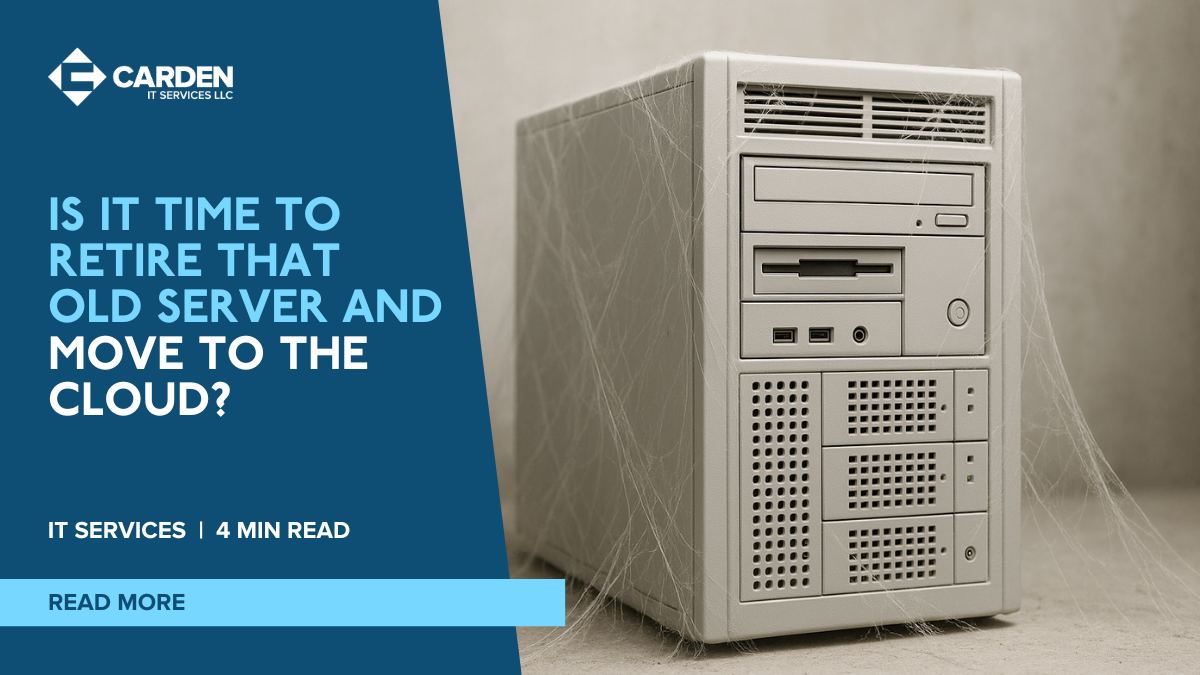Modern businesses depend on reliable technology. Email, shared files, databases, and critical software all run through your server. Yet many companies continue operating outdated servers that are slow, noisy, and past their supported lifespan. Holding on to aging equipment might feel cost-effective, but it often results in higher expenses, increased security risk, and unnecessary downtime.
This guide explains the dangers of outdated servers, how to identify when it is time to upgrade, and why transitioning to modern infrastructure or cloud services strengthens security, performance, and reliability. Whether you choose a new on-premise system, a cloud environment, or a hybrid approach, Carden IT Services provides expert planning and seamless migration support to keep your business running without disruption.
Signs Your Server Is Near Retirement
If you are unsure whether your server is approaching its end, watch for these issues:
- Frequent system crashes or freezing
- Slow access to applications or shared data
- More frequent IT tickets related to server performance
- Higher energy usage and increased cooling needs
- Notifications that your operating system or hardware are no longer supported
- Backups taking longer or failing intermittently
- Difficulty sourcing replacement components
If multiple signs apply, planning an upgrade now protects your business from a sudden failure later.
The Real Cost of Keeping Old Servers
1. Lost Productivity from Downtime
Every hour of unexpected downtime impacts employees, customers, and revenue. System failures delay projects, interrupt communications, and reduce client confidence.
2. Higher Maintenance Costs
Aging servers require more repairs, specialized labor, and hard-to-find components. Costs rise quickly as failure rates increase.
3. Increased Power Consumption
Older hardware consumes more electricity and generates more heat. Upgraded systems are far more energy efficient.
4. Security and Compliance Risk
Unsupported operating systems and unpatched software create cybersecurity vulnerabilities. Breaches can lead to data loss, legal liability, and reputational harm.
Why Upgrading to Modern Servers or Cloud Platforms Matters
Modern infrastructure provides more than speed improvements. Upgrading unlocks significant business benefits:
- Faster performance through SSD storage and newer processors
- Higher reliability with redundant components and improved failure protection
- Built-in cybersecurity features and current operating systems
- Scalable storage and compute resources that grow with your business
- Secure access for remote and hybrid teams
These improvements support long-term growth, not just day-to-day operations.
Cloud vs On-Premise vs Hybrid
When replacing a server, there are three primary options:
| Option | Advantages | Considerations |
|---|---|---|
| Cloud (Microsoft Azure, AWS etc.) | Scalable, secure, minimal maintenance, built-in redundancy, predictable monthly costs | Internet-dependent, storage growth may increase expenses |
| On-Premise | Local control, consistent performance, custom configurations | Higher upfront cost, maintenance responsibilities, limited scalability |
| Hybrid | Combines local control with cloud flexibility, ideal for phased migration | Requires careful planning and management across environments |
Carden IT Services evaluates your workloads and recommends the right approach for cost, performance, and future needs.
Security and Compliance
Older servers lack modern security capabilities. Upgrading helps support industry compliance requirements and puts advanced protections in place, including:
- Automated updates and security patches
- Central identity and access controls
- Multi-factor authentication
- Modern monitoring and threat protection
- Robust backup and recovery systems
Modernizing your infrastructure is a key step in protecting business data and reducing cybersecurity risk.
Business Advantages of Upgrading
- Faster applications and fewer interruptions
- Better uptime and business continuity
- Lower long-term operational costs
- Greater support for cloud tools, automation, and AI-driven processes
Upgrading your server prepares your business for future technology needs.
How We Deliver a Smooth Upgrade
- Review and audit your current environment
- Design the ideal infrastructure (cloud, hybrid, on-premise)
- Plan the migration and schedule around business hours
- Install, configure, and test the new system
- Provide monitoring and long-term support
Our team ensures minimal disruption and continuous business operations.
How Carden IT Services Supports Your Infrastructure Upgrade
- Infrastructure assessments and IT lifecycle planning
- Server replacement and cloud migration services
- Microsoft 365 and Azure deployment
- Hardware procurement and installation
- 24/7 system monitoring and proactive maintenance
Connect with Carden IT Services for a server health check and tailored upgrade plan.
Key Takeaways
- Servers typically need replacement every 3 to 5 years
- Delaying upgrades leads to higher costs and security risk
- Modern infrastructure improves security, performance, and scalability
- Professional planning ensures smooth migration with minimal downtime
FAQ
How do I know when my server needs to be replaced?
If your server is older than five years, running unsupported software, or frequently crashing, you should start planning a replacement.
Is cloud hosting always cheaper?
Not always. Cost efficiency depends on data volumes, workloads, and usage patterns. Many organizations choose a hybrid approach.
Will upgrading disrupt operations?
With correct planning, downtime is minimal. Carden IT Services schedules upgrades outside core business hours.
Can I use both on-premise and cloud servers?
Yes. Hybrid environments are increasingly popular due to flexibility and resilience.

